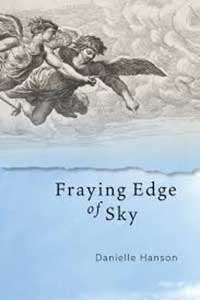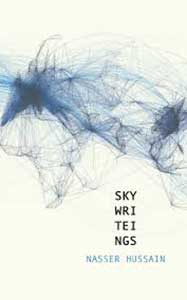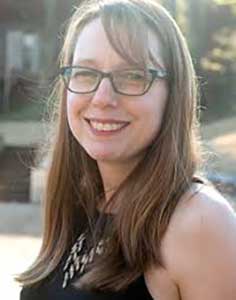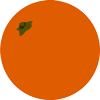Re- View #7:
Fraying Edge of Sky
Danielle Hanson, Codhill Press, 2018
&
SKY WRI TEI NGS
Nasser Hussain, Coach House Books, 2018
Jami Macarty & Nicholas Hauck, Co-founders & Editors


Jami: Welcome to the “friendly skies” of The Maynard! Re- View #7, just as Re- View #6, consists of two conversations about two “sky” books: SKY WRI TEI NGS by Nasser Hussain and Fraying Edge of Sky by Danielle Hanson. The Editorial Board at The Maynard has not yet had the pleasure of considering poems by Nasser Hussain, but we would very much like to do so. We’re interested in constraint-based, experimental, conceptual work like his (editorial prod: Reader, send us your experimental poems! Deadline: July 31.). We also like lyric, fabulist, allegorical work like Danielle Hanson’s. She contributed two poems to the Spring 2018 issue of The Maynard. The first leg of our journey will be to the Fraying Edge of Sky. In preparation for take off, fasten your seatbelt low and tight across your lap.


Upon first reading Fraying Edge of Sky, I came away with the sense that the collection of mostly short poems resides somewhere in the borderlands between two 20th century art movements. The 1920s avant-garde art movement Surrealism, which focuses on irrational juxtapositions of the unconscious mind, and which is often associated with French literature. I’m thinking here of the writers: Guillaume Apollinaire, André Breton, and Robert Desnos, among others. The other art movement, Magical Realism, came to the fore in the mid 1950s. Descriptive of writing (typically fiction) that mixes a realistic view of the modern world with magical elements, Magical Realism is associated with Latin American literature. I’m thinking of writers: Gabriel García Márquez, Jorge Luis Borges, and Isabel Allende.
Nick: It took me a few reads and some time to get into the worlds conjured by the collection—worlds or cosmologies comprised of mismatched characters from different sources. That’s one of things that struck me most about the collection, the way Hanson fuses, literally sometimes, figures from a range of myths. Now that I think about it, the composite nature of the poems was one aspect of the collection that caused my initial difficulty getting into it.
More than being poems of the mind, unconscious or otherwise, Hanson’s poems are situated in the world and in story… the poems rely on myth, fables, and allegory—the stuff of Magical Realism
Jami: Subsequent reads and the book’s epigraph, taken from Gabriel García Márquez’ tale “A Very Old Man with Enormous Wings,” left me more firmly grounded in the land of Magical Realism. More than being poems of the mind, unconscious or otherwise, Hanson’s poems are situated in the world and in story. The epigraph creates the affiliation and introduces one of the book’s themes—a “hell full of angels” (Márquez)—and generally, the poems rely on myth, fables, and allegory—the stuff of Magical Realism or Fabulism, as its sometimes called because of its links to fables.
Nick: I’m also wondering about the Pessoa epigraph to Hanson’s poem, “As He Is Reading a Letter from Her” (36): “the shadows have not yet completed their / slow coil around the clear presence of things.” How does the heteronymic—Pessoa is known for his imagined characters writing in different voices—relate to the way the poems are situated in world and story? What are the effects on the lyrical “I” and the form of the poems?
Jami: The form and length of the poems point to Magical Realism/Fabulism, too. There are three prose poems in the collection; at face value, this form is suggestive of Fabulism. Earlier, I mentioned “short poems.” The longest poem in the collection is 34 lines (Yes, I counted!); most are sonnet length, and the shortest poem amounts to two lines. The shorter length and form of the poems is part of what makes them act like allegories; the poems are short narrative or descriptive bursts that attempt to reveal something that’s been hidden—meaning, perspective, truth, reality—with moral or political underpinnings.
Nick: Right! I noticed each of the three sections of the collection begins with the shortest poems: four lines in “A Guide to Ridding Oneself of an Infestation of Angels” (3), three lines in “A Piece of Fog Like a Ribbon” (25), and two lines in “The Light Is Calling the Shadows” (47). Gradually getting shorter and shorter...
Jami: I greatly admire and appreciate short poems. They’re demanding—to write and read. While they may be read quickly, short poems tend to ghost the reader afterward and beg rereading. Shorter poems seem to have a longer afterlife, one that resides as much on the page as off it. Ethereal is the short poem.
Nick: Afterlife, yes! Throughout the collection, I get a sense of shifting presence and absence which is crafted with lines like “what happens in the hour when clocks fall forward” (32) and “breath is negative presence” (33).
Jami: That ethereal quality seems just right for these poems of the sky, the heavens, full of angels. The inclusion of angels in poems may conjure the poetic tone of sentimentality and mode of the lyric, but when the poems of Fraying Edge of Sky point at the lyric and its sentiment, they do so to call out angels, as Bohemian-Austrian poet Rainer Maria Rilke did in the Duino Elegies (1923). Hanson includes this reference in her poem “Time Lapse” (9):
Rilke said, every angel is terrible,
but he is the light that lies through its teeth.
What’s being dismantled within the poems—sentimentality, the lyric, belief in angels of good and God?
Rilke’s words echo those of the Márquez epigraph. Angels are at the center of Fraying Edge of Sky, which is partly “A Guide to Ridding Oneself of an Infestation of Angels” (3). Within the collection, Angels are likened to a “curse,” a “plague” and the operative verbs here are “ridding,” “dismantling,” “stripping.” What’s being dismantled within the poems—sentimentality, the lyric, belief in angels of good and God?
Nick: I sense little moral tone in the poems, so I’m not sure about good/God, but maybe the edifices of different beliefs are being taken apart, or reworked, reassessed, reassembled. There are references to repairing and rebuilding too, such as “The Tailor” (26), who
gets carried away,
begins sewing lizards, squirrels, opossums
to the sky. He creates
a daytime field of constellations,
embroidery for a new creation.
Or “Dr. Frankenstein at It Again” (62):
He has sewn three heads to a dog,
and it is terrible...
[then] turns Hell into Heaven and rests.
The amusing poem “List of Things to Be Imagined” (28) suggests creation too, but abstractly. What do you think the poems are saying about creative process, and art in general?
Jami: To some extent, it seems that beliefs about what it means to be human, as well as what it means to be an artist are being dismantled. The “dismantling” seems also to move beyond identity as human, as artist, to a “stripping” of self-ness and a stripping of a sense of permanence, as in “Instructions on Stripping” (5):
Throw away all that you were
into the opposite of wind.
Pretend to be a ghost.
Now pretend to be a rock.
What have you learned about permanence?
Nick: In a way, the fading of self is related to language, what it can and can’t do, and how we rely on it for identifying and knowing. One can imagine a “language which can crack stones” (28), but sometimes:
The only sentence you can say
in this language is a lie.
(“Howling,” 14)
The speaking self seems uncertain, almost disembodied, and questions itself:
I’ve been learning a lost language
by listening to your thoughts.
But when I look for my lips, I must look to your mouth.
(“Love Song,” 35)
There’s an uneasiness in this poem, the speaker seems almost possessed.
Jami: That questioning of self and permanence seems to be in response to both knowledge and experience—the knowledge of life in dystopia:
Now is the time to look for signs. The land
is on fire, it actually is, and what could this mean?
(“Signs,” 30)
and the experience of losing someone:
I am slowly replacing you
with hair I collect from your pillow.
I forgot to take a picture of your absence.
I deleted a picture of your absence.
(“List of Confessions,” 7)
Here, in these poems, pain and bitterness combine in a new realization of a world, where “Zombies instead of mummies, a more useful kind of dead” (“Exhale,” 22).
I’m struck by the emotional and physical transformations that take place in these poems
Nick: I’m struck by the emotional and physical transformations that take place in these poems: “The Zombie Minotaur” (17), “The Hydra as a Mummy” (15), “Angels as Mice” (27), “Medusa as a Vampire” (64), the self into… what? Loss? Erasure? These lines posit a curious take on the question:
True, things lost reappear.
But we would gladly exchange
missing for forgetting.
(“Fingers Leaving a Woman,” 54)
Jami: Forgetting and deleting are different, but that’s not so much the point here. What’s between the voluntary and involuntary is both the subject of the poems and the threshold on which they reside. Again and again in the poems a refutation of the binary arises. I get the sense the poems are trying to outrun the binary mode of thinking, of light/dark, etc. where the thinker is lobbed back and forth between opposites. In “Angels as Mice” (27), we’re told:
We must stop
being shepherds watching flocks at night.
It’s as if these poems are being chased by old (fashioned) ideas about mortality. Maybe that’s why there’s an urgency to these shorter poems, where the length matches their emphatic quality. Several poems include or begin with the imperative: “Take,” “Watch,” “Start,” “Collect”—
Take the rotten unused light of the moon,
add what the mirror sees when it is dark—
(“Instructions on Stripping,” 5)
...
Watch the flowers open and close with the light.
Watch them chew the air. Watch them eat lies.
(“Time Lapse,” 9)
...
Start with a balloon inflated with sky,
filter out the clouds—moisture adds weight.
(“How to Build a Bird,” 20)
...
Collect light in a bucket of water,
pour it off slowly—keep the light
from breaking, watch it seep into soil.
Now it is dark;
time to get rid of night.
(“The Experiment,” 21)
Nick: Yes, an attempt to escape the binary… does it, or can it succeed? The only (I think) plural imperative, “let’s look at that empty lot over there,” opens the poem “Urban Renewal” (39). The collective still struggles to think outside established dualisms: “let’s light it up” (39).
Jami: Let there be light! And, also its opposite. Let there be dark! A matter of anything is also its opposite. Most lyric poems are after light; Hanson’s lyric poems are after dark. That may amount to the same thing, but the getting there is different. Hanson’s poems want to look at darkness: “glorious night is being born out of the wreckage—” (“As He Is Reading a Letter from Her,” 36).
Nick: There’s definitely a suspicion of light in the poems, like in the two-line poem when “The Light Is Calling the Shadows” (47):
out to play,
ambushing them.
Hanson’s poems favour the dark, the murky, the shadowy, the space of change.
Hanson’s poems favour the dark, the murky, the shadowy, the space of change. Perhaps the metamorphic is the desired lyrical space, “sacrificing / form like a monk, or the dead?” (“Signs,” 30).
Jami: Through the darkness or into the night, may be the answer to Hanson’s “search for… another infinity” (“A Thousand White Insects,” 11). Regardless, something has to be done about the angels. This collection, which begins with the poem “A Guide to Ridding Oneself of an Infestation of Angels” (3) ends with the poem “Recycling the Angels” (67):
To waste an angel is a terrible thing.
Let’s navigate our attentions to the other “sky” book for Re- View #7: SKY WRI TEI NGS, Nasser Hussain’s constraint-based poems constructed entirely of three-letter airport codes.


I’m imagining my words traveling the flight path from YVR to you in YYZ. Let’s start with reader expectations. I approached SKY WRI TEI NGS with hesitant interest. I was curious about the book’s experiment, but worried I wouldn’t get it or be able to decipher the codes. A pre-reading question emerged: Is the book able to sustain its constraint?
Nick: I started with curiosity. I was drawn to learning more about the reasons behind Hussain’s artistic constraint, the process of using the constraint, and the outcome/s of the constraint-based project. Hesitancy came upon rereading the book, when I felt that I had nothing to say about the poems! I guess there was a disconnect between my expectations of a constraint-based project and Hussain’s realization.
Jami: Expectation and realization. This poet, and these poems, are part of the Oulipo group of French-speaking writers and mathematicians who use constraining techniques in their creative process. The Oulipo notion of constraint or limitation pertains to process. Artistic outcome or product is still based to some degree in chance and coincidence. We makers can follow constraints, but given relational alchemy and unforeseen variables, there’s no guarantee of outcome. That’s where the art either is or isn’t, I suppose.
Nick: I like that you brought up chance and coincidence, which seem to go against limits. Oulipo wanted to dissolve the apparent contradiction between freedom and constraint. “Potential literature” requires formal restrictions. In this sense, Oulipo is anti-chance, reacting to Surrealist hazard and Modernist free verse, which makes the references to Whitman in Hussain’s work all the more curious.
Jami: Just prior to opening the book, I Googled “airport codes.” One can find “every airport code in the world” at APC. Airport codes, defined by the International Air Transport Association (IATA), have been around since the 1930s. According to Wikipedia, they arose out of “the convenience brought to pilots for location identification.” Based on the two-letter code used by the National Weather Service (NWS) to identify cities, the three-letter system “allowed for 17,576 permutations, assuming all letters can be used in conjunction with each other.” Cool, right? I appreciate that the book pointed me toward adjunct reading and research before I read it.
In this collection, different flight/code combinations yield new destinations/linguistic configurations.
Nick: I’m wondering where the tension is in Hussain’s work. What’s the motivation for limiting himself to three-letter codes? Perhaps Hussain’s motivation comes out of a sense of play and challenge. Hussain’s biography as University of Windsor Writer in Residence states his “current poetic interest is in mass transit, and he is exploring the codes, mores, and histories of how we move and are moved.” So, he’s exploring structured freedom in movement, but pre-determined movement. In this collection, different flight/code combinations yield new destinations/linguistic configurations.
Jami: Linguistic permutations. Permutation: the operative word, the realm of this book. Permutations of engagement with a book—research, reading, and also how the book presents permutations of history and art. To read this book is to enter its sphere, its gravitational field, which includes literary and aeronautical history.
Nick: Can we talk about the maps for a bit? Drawn by Matthew Stephenson, they are literally writings in the sky, tracing flight routes between the cities whose codes make up the poems each map accompanies. These illustrations add another dimension to my engagement with the book, another level of play, more geometric, cartographic, offering child-like play, but firmly grounded in form. The way that the book assumes these different spheres and callously navigates them—at once a kind of ur-history marked with specific references to myth and individual experience—makes me feel, I don’t know, tricked in way. I find it hard to trust the constraint-based process, and I’m always a little on guard. Maybe this reaction is similar to yours, when you first approached the book.
Jami: At the crux of my worry about not “getting it”—that the codes would be used to make word puzzles, to manipulate and humiliate the reader. Plus, I refute the notion that poems are codes, needing to be decoded. The poem doesn’t need to be broken to be understood; it has its own terms. Since, I disagree with the ethos behind “unpacking” or decoding poems, I wasn’t sure I wanted to enter poetry that seemed to reinforce that thinking. Nasser seems aware of the code/de-code line of reasoning. How better to confront this mode of engagement with poems than to use codes! What’s different: the usage of codes is transparent for the reader.
Nick: There were times when this transparency of code usage shifted for me, and reading was turned toward figuring out what is being said. I had to reread some lines several times just to get it. This has nothing to do with metaphor or rhetoric. It has more to do with basic meaning. It’s similar to the feeling of learning a new language, like with the following:
EVE NLE SSC ENE SEL EVE
ESE NGR EKE. HEE REB ELS. (67)
The code takes time to “decipher,” not because the meaning is obfuscated but because of the system itself. The collection is using a “language” in a way that it was not meant to be used, so not only do readers have to “learn” Hussain’s codes, but they also have to make sense of the methods of meaning making.
Jami: Right, the poet configures codes from one lexicon to make something else. There’s a two-ness within each usage—there’s the code/s and there’s its turn toward a word. That seems to point to the poems’ primary “aboutness”: language. The system, structure, pronunciation, style, and expression of language and communication. Communication, that round trip on which the writer and reader join each other. I call the aisle seat!
Nick: Throughout the book there are messages directed to the reader, extending the metaphor of a flight. The book opens: “WEL CUM ABO ARD” (7), so right away the complicity is self-aware. The second “section” (flight segment?) begins with “SLI GHT DEL AYS” (28). Later, the trope of air travel experience is palatable with “CHI KEN ORP AST AHH? (48).” I’m wondering about how this “choice” relates to the larger play on constraints and limits. How free is the poet given the rules of the game? On the penultimate page of the collection, we read:
THA NKS FOR
TRA VEL LIN
WIT HUS (88)
So, maybe even as readers, our itinerary has been set out for us. In agreeing to read the poems, are we committing to the constraints as well?
Jami: More on reader expectations, which seems par for our conversation on this constraint-based book. Together, the book’s title, the first section’s epigraph/epigraph-acting poem, and the first two poems of the collection set me up to expect a narrative on aeronautics, one focusing on history of flight, the travel and migration of people. When I arrived at the poem “AIR TRA VEL” (11), and read its one line: “MIG RAT ION,” I got goose bumps. I had the thought, “O, wow, here we go; here’s a book taking on one of the most pressing issues on and for the planet.”
Nick: I felt a sense of mischief present from takeoff. There are other, and in my mind, more interesting topics than flight which have preoccupied humans since, well, forever. My expectations were pulled toward play, process, (air)craft.
This book, perhaps unlike the other books reviewed in this series, foregrounds the poet/maker, at least as much as the poem/made.
Jami: Even the fourth poem, “ALF AAH BET” (13) seemed at first to be associated with this narrative, perhaps offering comment on learning new systems and sounds of communication. I imagined immigrants coming to new lands, being confronted with a new language. However the fifth poem busted that expectation of narrative, turning from the topical toward sound-play. Busted expectations of narrative—I’d expect nothing less from a book coming out of the constraint-based tradition. As the book moved into sound-play, it seemed to assert itself as a project of the various permutations a poet, this one: Nasser Hussain, can make with three-letter airport codes. This book, perhaps unlike the other books reviewed in this series, foregrounds the poet/maker, at least as much as the poem/made. Or, does it foreground the making—the process, the experiment?
Nick: Good question! I’ll respond with the help of the short two line “APP REY ZZV OUS” (37):
PST MON AMI
TOU EST FOU
The poem’s title is formal, polite, and is a nod to the poetic lineage Hussain imagines for this work. The poem’s two lines are more intimate, secretive even. This is one of the few places in the collection where I feel the poet is highly aware of his role, calling himself out for the “craziness” of the project. The second alphabet poem, “ALF AAH BET (2)” (85) contains letters of the Roman alphabet spelled out phonetically. That gets back to the narrative of learning new systems and sounds. The fact that it’s the third to last poem makes me wonder who is learning. More than anything, I feel the process is what’s being brought to the fore. Did you pick up on any other narratives?
Jami: Some poems take up biblical themes: The Fall, The Flood. Others span comics and children’s literature:
FLY HIE (FOR BEE)
IZT BRD?
PLN?
KNO!
SPR MAN!
(LEX LUT HOR: RUN!) (25)
Then there’s “THE CAT THE HAT” (60-63), the longest poem in the book, which according to the notes, “is an erasure of the original book that preserves only the punctuation and the airports.” To which, I heard my mind say: UMM, WOT? WYE? For me, this is where the constraint-based experiment goes off the rails. I don’t think this experiment is successful enough to have been included in the book. Sorry, Nasser! “THE CAT THE HAT” is not enough of a variation on the original. Up until (and after) “THE CAT THE HAT,” the airport codes are used—to make something, if not new, then something familiar newly. In the process, an otherness—art (?)—emerges. I guess that’s what’s missing from my reading of “THE CAT THE HAT”—there’s no “otherness.” As well as bringing up the question: What is art? the “rewriting” of Dr. Seuss’ work brings up questions of authorship.
Nick: I’m with you on “THE CAT THE HAT.” I don’t see, nor do I get its place in the book. It seems derivative and distracts from the other more interesting and important parts of the project. I think the mode of rewriting stories works in “JAC AND THE” (72), where the two lines that make up the poem:
FIE FLY
FOE FUM
are a fitting, melodic evocation of the fairy tale.
Jami: The poems are often charming; sometimes they hit corny notes. They romp and poke fun, mixing in honor and respect. I’m thinking of the homages to Modern American poets Gertrude Stein, Ezra Pound, and William Carlos Williams, to experimental Canadian poet Christian Bök, and to the “father of free verse,” Walt Whitman. I’m curious about why I accept the permutations of “TEN DRR BUT TON (FOR GER TIE)” (29), which according to the notes, “rewrites the Contents page from the Food section of Gertrude Stein’s Tender Buttons” and the rewrite of William Carlos Williams’ “The Red Wheelbarrow” (65), but not “THE CAT THE HAT.” The code operation’s the same. Isn’t it? Herein lies the mysteries of outcome! Or, is Hussain code-twitching during the composition process?
SUM OCH DEP END
SUP ONA
RED WEL ELB
ARR OGG
from “DEP END – TOO (FOR SUS)” (65)
Nick: In the homage to Pound, like with the “Jack and the Beanstalk” reference, what makes the poem work is how it exists within the so-called guidelines of the project. In pieces like these, Hussain’s craft shines because I feel he is both respecting and playing with the reader.
Jami: Along with this perhaps “high brow” literary note, the poems also register colloquialisms, dialect, and the vernacular, conjuring a particular country, region, or community. Maybe it’s inevitable, given the number of poems in sound-play, that speech registers evoke Rap, Hip Hop, the speech of text and personals. The book, then, is also a celebration of the vernacular, bringing language of all types to life, to art.
There’s a difference between paraphrasing in airport code some of the most widely known poems/poets and playing on the sounds of that same code to evoke varying registers of speech.
Nick: The different registers definitely add a celebratory, inviting element to the work. It’s fun to read high modernist poetry or the story of The Flood “translated” into airport code, or into the language of SMS. The resonance with Hip Hop and slam poetry comes through in many poems. I’m tempted to venture into the forbidden skies of intention, though. In a way, as you say, it may be inevitable given the constraint game being played, but I’m not sure how to reconcile that with the poet’s intentions behind referencing “The Red Wheelbarrow.” There’s a difference between paraphrasing in airport code some of the most widely known poems/poets and playing on the sounds of that same code to evoke varying registers of speech. In this context, the sound-play feels natural, while the “highbrow” references seem forced.
Jami: Another theme within the poems: the inevitably of what (language)/who is lost, especially within race relations. There are poems that try for justice. One of the most hard-hitting, affecting is:
ISL AMO PHO BIA
USA USA USA USA USA USA USA
USA USA USA USA USA USA USA
USA TOO WIT TER HAT ERS USA
MAK EAM ERI CAG REA TAG AIN
USA USA USA USA USA USA USA
USA USA USA USA USA USA USA
This poem marks a chilling moment within the collection. Terrifying, too—the way the text “USA” is in military formation, flanking the other text.
Nick: “BOX DRE AMS” (24) addresses racism and confinement from another angle, dramatizing the boxing ring as a microcosm:
ALI BOO KLU
KLX
KLN
KKK
...
ALI BOX FOE
BAM HIS EAR
BUS DAT LIP...
Jami: In the poems that address injustices perpetrated on women, I find hints of misogyny or of trivializing our struggles. The risk of trivialization seems inherent here because abbreviations axiomatically contract, elide, make small. What’s being shortened, compressed? By what rationale, on the basis of what experience or knowledge? To what effect (on the world, others)?
The risk of trivialization seems inherent here because abbreviations axiomatically contract, elide, make small.
Nick: I think there’s a danger in using a lexicon made up entirely of codes to which the poet is blind. “APE MAN” (21) points to this, containing 33 terms for men (BOI, BOY, DIK, FAG, GUY, SIR, SUN, etc.). There’s no such poem for women, and the apparent objectivity of the coding system is broken open. We are, after all, working and reading within a specific cultural context that is not completely open and innocent, one which carries with it prejudices. There are moments that border on misogyny for sure, and others that address LGBTQ2+ folks with similar dismiss.
Jami: I could only come up with SHE, MAM, DYK, GAL and note that these might be found objectionable. I doubt Nasser Hussain sanctions dismissal of any individual’s or group’s struggles. That said, and if others also experience some of the poems as trivializing and dismissive then what rationale—and whose—underlies their apparently uncritical inclusion? It seems safe to assert that constraint-based works are held to the same ethical standard as others. Regardless of artistic constraint and process, the artistic product is still imbued with choice. It’s the poet who chooses the experiment (constraint) and then what to “do” with its results. The poet must discriminate between what CAN be done and what SHO ULD be done.
